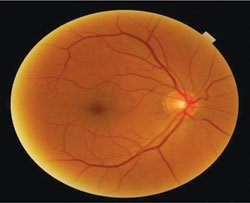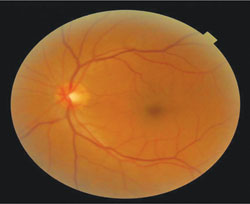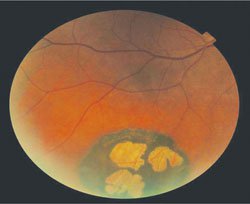Midperipheral lesion discovered at refractive exam
 Leo P. Semes |
A 62-year-old white male came into our clinic for new glasses. He reported hypertension, diabetes and arthritis.
His medications were glyburide, 5 mg twice daily; metformin, 50 mg twice daily, and human insulin NPH U-100, 10 mL, 5 units injected at bedtime, for diabetes; loratadine, 10 mg once daily and naphazoline 0.1% at bedtime for allergy; lisinopril, 5 mg twice daily for blood pressure; carvedilol 80 mg capsules daily for heart failure; celecoxib 100 mg twice daily for pain from osteoarthritis; and vardenafil 20 mg as needed for intercourse.
His best corrected visual acuity was 20/20 in both eyes with a manifest refraction of plano OD and plano +0.50 x 005 OS and a bifocal add of +2 D.
Versions were smooth and full, and confrontation visual fields were full. Pupils were equal, round and reactive to light. His IOP was OD 19 mm Hg and OS 17 mm Hg. Examination of the anterior segment was unremarkable.
Examination of the posterior segment was unremarkable in the central posterior pole in both eyes. In the peripheral posterior pole of the right eye, a large retinal lesion was evident.

What’s your diagnosis?
Retinal lesion
The differential diagnosis includes diabetic retinopathy, hypertensive retinopathy, choroidal nevus, melanoma, acquired pigment epithelial hyperplasia and congenital hypertrophy of the retinal pigment epithelium (CHRPE). This patient’s findings were consistent with congenital hypertrophy of the retinal pigment epithelium.
The pigment epithelium of the retina and ciliary body is composed of a monolayer of cuboidal and columnar cells containing numerous pigment granules. These cells derive from the outer layer of the primitive optic cup and are located between the photoreceptors and the basal lamina (Bruch’s membrane).
The pigment epithelium has a different embryologic tissue origin than that of the choroidal melanocytes, which gives rise to different acquired disease manifestations. The pigment epithelial cells can undergo reactive proliferation and migration. The choroidal melanocytes are branching, dendritic cells that are interspersed in the uveal space and are believed to originate from the neurocrest. They are capable of neoplastic transformation but are not inherently able to undergo reactive proliferation and migration. The pigment in either case is melanin.
CHRPE may be either unifocal or multifocal. Unifocal CHRPE results in pigmented, flat, round lesions with distinct margins Areas of congenital hypertrophy range from light brown to jet black, depending on the amount of melanin in the epithelial cells and the degree of hypertrophy. Throughout life there can be degeneration of the epithelial cells, and the pigmentation of the clinical presentation may change. The overlying retinal blood vessels appear normal.
 Central posterior pole of the right eye.  Central posterior pole of the left eye. |
 Peripheral posterior pole of the right eye. Images: Bockin D |
The lesions are almost always stable in size, but their color may change because of chorioretinal degeneration and atrophy as described above. On rare occasion they have been shown to enlarge over many years, but the growth is usually minimal. A full or partial hypopigmented ring is often seen around the lesions; this ring or halo is composed of epithelial cells devoid of melanin granules and is sometimes incorrectly diagnosed as a halo nevus. The halo is an important clinical finding, for it denotes that the lesion is a CHRPE.
Areas of pigment mottling and chorioretinal atrophy often occur; the areas of chorioretinal atrophy produce window views of the underlying structures and are known as lacunae. The lacunae allow a clear view of the underlying choroid and often of the sclera when located in the periphery.
When the lesion is mostly filled with lacunae, it begins to look like a patch of paving stone atrophy, but it is identifiable as a CHRPE undergoing age-related degeneration by the thick pigmented margin and the residual pigmented septa or nubbins all radiating centrally. One or many lacunae may be present within the boundary of the lesion. The lacunae may enlarge over time. These lesions are quite common, although an estimated percentage for the general population has not been reported.
CHRPE can be found in any location of the retina, from adjacent to the ora serrata to a crescent around the optic disc, but about 70% occur in the temporal half of the fundus. CHRPE is most frequently found in the periphery and rarely in the macula. A submacular CHRPE that inhibited macular drusen formation has been reported.
When a unifocal CHRPE is found in the region of the optic disc, often it partially surrounds the disc margin but abruptly ends at the edge of the disc. When it is found in the far periphery of the retina, it ends just before the ora serrata or immediately at the pars plana, never extending onto the pars plana. CHRPEs can be scattered throughout the fundus.
Diameter usually varies from 2 mm to 6 mm, but they have been known to range from a pinpoint to 14 disc diameters. Peripheral lesions tend to be larger than posterior lesions. A unifocal CHRPE is usually unilateral, but it does occur bilaterally in about 1% to 2% of the cases.
Solitary lesions essentially never produce symptoms, and there is no predilection for gender or laterality. Unilateral scotoma may be plotted at visual field examination but outside the posterior pole; these are usually of no consequence to visual performance. Although CHRPEs are probably more frequently discovered in whites, there seems to be no racial predisposition when studies are corrected for racial population densities. A CHRPE may be present as early as birth; they have been found in infants as young as 3 months of age.
Patients with familial adenomatous polyposis coli (FAP) and related Gardner’s syndrome may display CHRPE lesions that may represent hamartomas and not just hypertophy of the pigment epithelium. The CHRPE of FAP are often distinguishable from typical lesions by their bilaterality, familial history, multiple lesions (more than three), nonsectorial organization and associated systemic abnormalities. There is no gender predilection. Typical solitary and multifocal CHRPEs are not associated with FAP or Gardner’s disease.
The prognosis for CHRPE is usually good, but in some cases a CHRPE has transformed into a malignant growth. If a CHRPE occurred in the fovea, the loss of photoreceptors could result in decreased vision, but this is an extremely rare event.
The CHRPE’s location and estimated size should be noted on the patients’ record. Fundus imaging is often helpful if the lesion is observable with imaging. The lesion should be evaluated in 6 to 12 months to document stability.
Reference:
- Jones W. Peripheral Ocular Fundus, 3rd ed. St Louis, MO: Butterworth Heinemann Elsevier; 2007.
- Donald G. Bockin, OD, can be reached at 1174 Windy Hill, Salado, TX 76571; donbockin@gmail.com.
- Edited by Leo P. Semes, OD, a professor of optometry, University of Alabama at Birmingham and a member of the Primary Care Optometry News Editorial Board. He may be reached at (205) 934-6773; fax: (205) 934-6758; lsemes@uab.edu.

